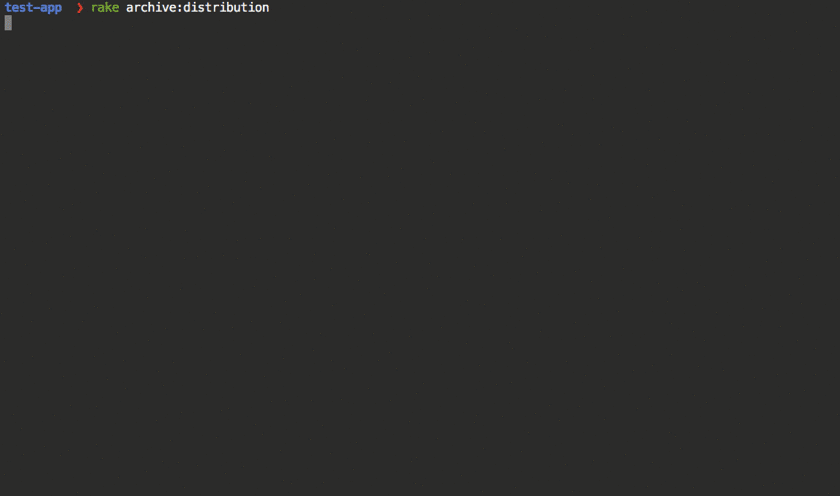Simplified provisioning for RubyMotion iOS, tvOS and macOS apps.
Getting started with iOS development has a very high barrier. Just getting a app and device registered requires you to go through a very complex web interface at developer.apple.com
motion-provisioning significantly alleviates the pain of these steps.
By providing your developer account, motion-provisioning automatically performs the following tasks in the Developer Portal for you:
- Creates an application matching your app's name and bundle identifier.
- Creates development and distribution certificates.
- Creates development, distribution and adhoc profiles.
- Registers iOS devices.
For more awesomeness, use motion-provisioning along with motion-appstore!
Add this line to your application's Gemfile:
gem 'motion-provisioning'And then execute:
$ bundle
MotionProvisioning provides two handy methods. Pass them to the
app.codesign_certificate and app.provisioning_profile options in
the Rakefile.
MotionProvisioning.certificate(platform: platform,
type: type
free: free)| Parameter | Description |
|---|---|
platform |
:ios, :tvos, :mac |
type |
:development, :distribution, :developer_id (only mac) |
free |
true if you want to use a free developer account. Default: false |
MotionProvisioning.profile(bundle_identifier: bundle_identifier,
app_name: app_name,
platform: platform,
type: type
free: free)| Parameter | Description |
|---|---|
bundle_identifier |
Pass app.identifier |
app_name |
Pass app.name |
platform |
:ios, :tvos, :mac |
type |
:development, :distribution, :adhoc (only iOS and tvOS), :developer_id (only mac) |
free |
true if you want to use a free developer account. Default: false |
Here's how you would configure an iOS app:
Motion::Project::App.setup do |app|
app.name = 'My App'
app.identifier = 'com.example.myapp'
app.development do
app.codesign_certificate = MotionProvisioning.certificate(
type: :development,
platform: :ios)
app.provisioning_profile = MotionProvisioning.profile(
bundle_identifier: app.identifier,
app_name: app.name,
platform: :ios,
type: :development)
end
app.release do
app.codesign_certificate = MotionProvisioning.certificate(
type: :distribution,
platform: :ios)
app.provisioning_profile = MotionProvisioning.profile(
bundle_identifier: app.identifier,
app_name: app.name,
platform: :ios,
type: :distribution)
end
endThe certificates and profiles will be created and downloaded into a
provisioning folder in the root of your application folder as part of running
rake archive:distribution or rake device.
The output path can be configured by setting MotionProvisioning.output_path:
MotionProvisioning.output_path = '../my_provisioning'The first time you run MotionProvisioning, you will be asked for your Apple ID
email. It will optionally be stored in a YAML config file in
provisioning/config.yaml.
You will then be asked for your password, which will be stored securely in the Keychain.
If your account belongs to multiple developer teams, you will be asked to select the one you want to use. It will also optionally be stored in the config file.
If there are multiple team members, it's very important each team member uses a different account. Read "Sharing cerfiticates" below to know more.
The config file will look like this:
email: foo@example.com
team_id: 5GU5F4Alternatively, you can provide all this information via environment variables:
MOTION_PROVISIONING_TEAM_ID
MOTION_PROVISIONING_EMAIL
MOTION_PROVISIONING_PASSWORD
If you dont have a paid Apple developer account, set the free:
option to true and a free development certificate and development
profile, valid to deploy to your device, will be created. You still
need a paid account to submit an app to the AppStore.
You can register a free developer account in developer.apple.com
Apple imposes restrictions in the number of certificates you can create:
- One development certificate per team member.
- One distribution certificate per team.
The distribution certificate (and it's corresponding private key) must be shared between all team members who will be creating distribution builds.
motion-provisioning will ask before revoking the existing distribution certificate and creating a new one.
After you create a new distribution certificate, share the
corresponding .cer and .p12 files located in the provisioning
folder with your team members.
After copying the files to the team member's provisioning directory,
drag and drop the certificate file into the Keychain Access app's login
keychain in order to install the certificate.
Once the certificates and profiles are cached in the provisioning
folder, if you want to re-create them, set the recreate_profile or
recreate_certificate env variable.
For example, to recreate the development profile:
rake device recreate_profile=1
Or to recreate the development certificate:
rake device recreate_certificate=1
Or to recreate the distribution certificate:
rake archive:distribution recreate_certificate=1
motion-provisioning does not (yet) manage entitlements and app services (like
HealthKit, HomeKit or iCloud). To enable them, you need to go to the Developer
Portal. Then, recreate your provisioning profile and add the appropriate
entitlements to the app.entitlements hash in your Rakefile.
If there are any iOS devices connected to the computer, and they are not included in the provisioning profile, you will be asked to register them in the Developer Portal and include them in the profile.
You can also add arbitrary device IDs by running:
rake "motion-provisioning:add-device[device_name,device_id]"
Then, you will need to recreate the profile to include the newly registered device:
rake device recreate_profile=1
Run:
bin/setup
rspec
To generate profiling information:
SPEC_PROFILE=1 rspec
To generate coverage information:
SPEC_COVERAGE=1 rspec
